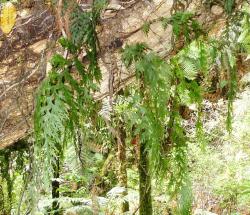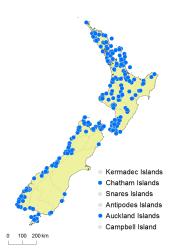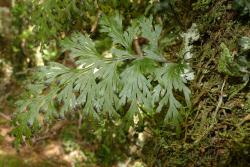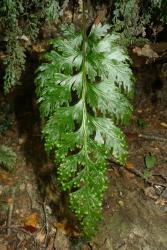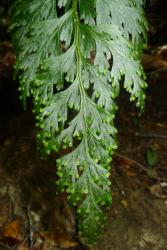- ≡ Trichomanes dilatatum G.Forst., Fl. Ins. Austr. 85 (1786)
- ≡ Sphaerocionium dilatatum (G.Forst.) C.Presl, Hymenophyllaceae 35 (1843)
- ≡ Diploophyllum dilatatum (G.Forst.) Bosch, Verslagen Meded. Afd. Natuurk. Kon. Akad. Wetensch. 11: 323 (1861)
- ≡ Mecodium dilatatum (G.Forst.) Copel., Philipp. J. Sci. 67: 24 (1938)
- = Leptocionium sororium C.Presl, Gefässbündel Farrn 28 (1847)
- ≡ Hymenophyllum sororium (C.Presl) Bosch, Ned. Kruidk. Arch. 4: 395 (1859)
Epiphytic or rarely terrestrial ferns. Rhizomes long-creeping, 1–1.5 mm diameter, bearing thick red-brown hairs up to 2 mm long, densely clustered at bases of stipes, scattered elsewhere. Fronds 60–570 mm long. Stipes 10–150 mm long, brown or sometimes green distally, narrowly winged for at least half their length, glabrous or bearing a few scattered hairs; stipe wings planate. Laminae 3–4-pinnatifid, ovate or elliptic, 45–450 mm long, 40–170 mm wide, green, membranous, 2–4 cells thick, glabrous or with very short scattered hairs on costae. Rachises broadly winged throughout, reddish brown or sometimes green distally, glabrous or with a few scattered hairs; rachis wings planate. Primary pinnae in 6–20 pairs, overlapping, winged throughout; distal portion of primary pinnae recurved or straight or incurved; distal primary pinnae narrowly ovate or narrowly elliptic or ovate or elliptic, adnate; proximal primary pinnae ovate to broadly ovate, adnate; the longest primary pinnae from the middle to the base, 20–140 mm long, 13–75 mm wide. Secondary pinnae arising both acroscopically and basiscopically, sometimes overlapping, winged throughout, adnate; narrowly elliptic to narrowly ovate on distal primary pinnae, ovate or elliptic on proximal primary pinnae; the longest secondary pinnae 9–45 mm long, 3–20 mm wide. Ultimate lamina segments oblong, up to 10 mm long, 1.5–2 mm wide; apices obtuse or occasionally acute; margins entire, with a slightly thickened indistinct border; distal segments on primary pinnae slightly recurved or divergent or slightly curved towards frond apex. Sori borne on short acroscopic and basiscopic segments throughout pinnae, solitary on each segment, many on each primary pinna, partially immersed in lamina; indusia bivalvate; indusial flaps elliptic to almost orbicular, 1.3–2.5 mm long, apices obtuse, margins entire; receptacles included within indusial flaps or slightly exserted.
Hymenophyllum dilatatum is the largest of the New Zealand filmy ferns, recognisable by its creeping rhizomes, glabrous laminae with entire margins, broad flat wing along the rachis and much of the stipe, very broad pinnae and pinna segments, and large almost round indusia partially immersed in the lamina.
North Island: Northland, Auckland, Volcanic Plateau, Gisborne, Taranaki, Southern North Island.
South Island: Western Nelson, Sounds-Nelson, Marlborough, Westland, Canterbury, Otago, Southland, Fiordland.
Chatham Islands, Stewart Island, Auckland Islands.
Altitudinal range: 0–1060 m.
Hymenophyllum dilatatum occurs in lowland to montane forest throughout the North Island from Cape Reinga southwards, except for some of the east coast. It grows from sea level to over 1060 m on Mt Hauhungatahi in the central North Island. In the South Island it is largely confined to lowland and montane areas west of the main divide. It is absent from most of the east coast and interior except for populations around Dunedin, the Catlins district and isolated populations on the Marlborough and south Canterbury coast. It extends from sea level to 950 m near Boulder Lake, north-west Nelson.
Although Hymenophyllum dilatatum has been reliably reported from Banks Peninsula (Lovis & Daellenbach 1982; Koller & Tripp 2010; Wilson 2013), no voucher specimen has been found in AK, CHR or WELT, and its presence there is not shown on the distribution map.
Occurs under tall kānuka scrub, and in kauri, podocarp, beech and broadleaved forest, growing on the ground, on river banks, rock faces and fallen logs and trunks, or as an epiphyte in wet areas. It has been recorded most frequently on Cyathea medullaris, Dicksonia fibrosa and D. squarrosa but also on Elaeocarpus dentatus, Melicytus ramiflorus, Prumnopitys taxifolia and Coprosma chathamica (on the Chatham Islands).
n = 36 (Brownlie 1958).
Hymenophyllum dilatatum, together with H. nephrophyllum and H. scabrum, is unusual in the genus in having a frond that is more than one cell thick. Holloway (1923) showed that sporelings had a lamina only one cell thick and that the multi-layered condition developed with maturity.



